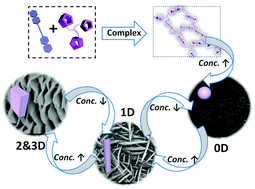
Zhao et al. use techniques including dynamic light scattering, scanning electron microscopy and transmission electron microscopy to permit the detailed examination of these elegant supramolecular assemblies.
Acetone mixtures of the two components produce small building blocks at concentrations of 0.5 mM, with expanding aggregates rolling into hollow nanospheres when concentrations approach 1 mM. Beyond this concentration large flat layers are created, which stack at concentrations in excess of 2 mM. In essence the system demonstrates a reversible multidimensional transformation from 0D to 3D, and is an example of controlled dynamic self-assembly. This represents a novel method for developing new functional materials with a switchable morphology control.
| Host–guest complexation driven dynamic supramolecular self-assembly Huacheng Zhang, Kim Truc Nguyen, Xing Ma, Hong Yan, Junfei Guo, Liangliang Zhu and Yanli Zhao DOI: 10.1039/C2OB27340C Free to access for 4 weeks |
Published on behalf of Steve Moore, Organic & Biomolecular Chemistry web science writer.










